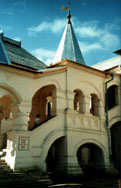 Rostovskaya Oblast is situated in the south of the East European plain near Caucasus. The oblast is washed by the Gulf of Taganrog of the Sea of Azov. Rostovskaya Oblast borders upon Stavropol and Krasnodar Territories, Ukraine, Voronezhskaya Oblast, Volgogradskaya Oblast and the Republic of Kalmykia. Rostovskaya Oblast is situated in the south of the East European plain near Caucasus. The oblast is washed by the Gulf of Taganrog of the Sea of Azov. Rostovskaya Oblast borders upon Stavropol and Krasnodar Territories, Ukraine, Voronezhskaya Oblast, Volgogradskaya Oblast and the Republic of Kalmykia.
The main rivers are Don and Northern Donets. There are some lakes and three water basins Tsymlyanskoye, Veselovskoye and Proletarskoye.
The climate is moderately continental. The average temperature of January is -9 degrees (in the north) and -5 degrees (in the south), the average temperature of July varies from +22 and +24 degrees centigrade. Precipitations are of 400-650 mm a year.
Rostovskaya Oblast was formed on September 13, 1937. Its area is 100,8 thousand sq. km. Distance between Rostov-on-Don and Moscow is 1226 km. The oblast is divided into 42 districts, 22 cities and towns, 16 urban districts, 37 urban, 416 villages. The regional centre is Rostov-on-D on. The city was founded in 1749. on. The city was founded in 1749.
The population of the oblast (January 1, 1998) is 4387,6 thousand people. Density of population makes 43,5 per sq. km.
The largest cities are Rostov-on-Don (1008,5 thousand inhabitants), Taganrog (288,6), Shakhty (225,1), Novocherkassk (186,1), Volgodonsk (181,2), Novoshakhtinsk (103,3).
Rostovskaya Oblast is rich in cultural, historical and folklore traditions. It is the native land of great Russian writers Chekhov and Sholokhov. This land lies on the junction of caravan and trade ways between West and East, North and South. That is why it is very interesting for archeologists. Many monuments are preserved even today.
Rostov-on-Don is one of the largest cities of the South of Russia. It is the industrial, scientific and cultural centre of the North Caucasian region of the country. The city is situated at the junction of Northern Caucasus, Central Russia and Ukraine. Therefore the city of the Don Cossacks is often called "The Gate of Caucasus".
|













 State
State  Regions
Regions